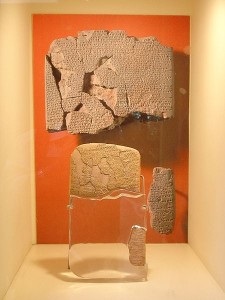Historical fantasy author Judith Starkston describes a day in the life of Puduhepa, Queen of the Hittites.
~~~
 Relevant History welcomes back Judith Starkston, author of the award-winning historical fantasy Priestess of Ishana and the Trojan War novel Hand of Fire. She has degrees in Classics from the University of California, Santa Cruz and Cornell. Priestess of Ishana combines history with magical elements found in Hittite rites, and in the series, Queen Puduhepa is renamed Tesha after the Hittite word for “dream.” (Read the post to find out why.) To learn more about Judith and her books, visit her web site, follow her on Facebook and Twitter—and sign up for her newsletter to receive a free Bronze Age short story and cookbook.
Relevant History welcomes back Judith Starkston, author of the award-winning historical fantasy Priestess of Ishana and the Trojan War novel Hand of Fire. She has degrees in Classics from the University of California, Santa Cruz and Cornell. Priestess of Ishana combines history with magical elements found in Hittite rites, and in the series, Queen Puduhepa is renamed Tesha after the Hittite word for “dream.” (Read the post to find out why.) To learn more about Judith and her books, visit her web site, follow her on Facebook and Twitter—and sign up for her newsletter to receive a free Bronze Age short story and cookbook.
*****
 Queen Puduhepa pressed her seal into the first extant peace treaty in history. The Treaty of Kadesh was between her kingdom of the Hittites (in what is now Turkey) and Rameses II, Pharaoh of Egypt, during the Late Bronze Age, in the thirteenth century BCE. In the twentieth century, her letters, treaties, religious codifications and judicial decrees came to light when archaeologists dug up the great cuneiform libraries of her capital, Hattusha.
Queen Puduhepa pressed her seal into the first extant peace treaty in history. The Treaty of Kadesh was between her kingdom of the Hittites (in what is now Turkey) and Rameses II, Pharaoh of Egypt, during the Late Bronze Age, in the thirteenth century BCE. In the twentieth century, her letters, treaties, religious codifications and judicial decrees came to light when archaeologists dug up the great cuneiform libraries of her capital, Hattusha.
She reigned for some seventy years. At about fifteen she married Hattusili, who later became the Great King of the Hittites and she the queen. In the years following her reign, unknown forces destroyed and buried the Hittite Empire, and this remarkable queen was forgotten to history. From clay tablets, now deciphered and translated, we can reconstruct some of the typical events from a day in the life of Puduhepa.
Even the water matters
As Puduhepa’s hypothetical day begins, she reaches for that first cup of water to quench her morning thirst. From one of the tablets, we have instructions to palace personnel about the royal water:
All the kitchen personnel—the cupbearer, the table-man, the cook, the baker, the dairy man (the list goes on) you will have to swear an oath… Fill a bitumen cup with water and pour it out toward the Sun-god and speak as follows: “Whoever does something in an unclean way and offers to the king (or queen) polluted water, pour you, O gods, that man’s soul out like water!”
and
You who are water carriers, be very careful with water! Strain the water with a strainer! At some time I, the king, found a hair in the water pitcher in Sanahuitta. I expressed my anger to the water carriers “This is scandalous. … If he is found guilty, he shall be killed!”
According to the Hittites, a hair could be used to place a curse on the king or queen. Just slip the correct hair in with the proper incantations, and you could shorten the king’s life, cause him a wasting illness, or any number of other mysterious problems. Curses were a regular concern—which explains the stiff penalty in this case, although ritual purity in general for the royal family was a tremendous concern for reasons of proper relationship and harmony with the gods rather than notions of healthfulness.
Setting things right with the gods
Once Puduhepa refreshes herself with water free from any curses, she might prepare herself to go to the temple to make offerings and pray. Puduhepa’s love and devotion for her husband were legendary. They met accidentally—except they both attributed it to their patron goddess Ishtar—and it was love at first sight. In a dream, Ishtar commanded Hattusili to marry Puduhepa. Puduhepa also had dreams from Ishtar regularly, and these two mystics, who led extremely pragmatic lives, found great solace in each other. When Hattusili was ill, as he often was both with a mysterious eye ailment and something painful in his feet, Puduhepa prayed fervently for his health.
In the inner sanctum of the temple where only the royal family and the priests were allowed access, Pudhepa makes offerings to the divine statues of the gods. Each day priests and priestess provided food and drink for and bathed and dressed their gods. In this brightly frescoed space, before gold and silver statues draped in finery, Puduhepa offers a goat or bull for sacrifice. She has selected bread offerings from a myriad of shapes—today perhaps a hand or bird—and her breads are sweetened with honey and soaked in olive oil.
To ensure her husband’s health, she beseeches the gods to bring Hattusili long life and well-being. In one of her extant prayers, she opens by reminding the Sun-goddess Arinna that Hattusili had recaptured the goddess’s sacred city of Nerik, and the traditional offerings to her are once again being made there. After this reminder of the goddess’s debt to Hattusili, Puduhepa goes on to make this plea:
Since I, Puduhepa, am a woman of the birthstool (a midwife or possibly a mother of many children), … have pity on me, O Sun-goddess of Arinna, my lady, and grant me what I ask of you! Grant life to Hattusili, your servant! Through the Fate-goddesses and the Mother-goddesses may long years, days and strength be granted to him.
Later in the same prayer, now directed to one of Arinna’s attending goddesses, Puduhepa suggests that maybe someone has made an offering to the gods to damage Hattusili or has otherwise cursed him, and that this goddess should undo that harm. In return Puduhepa will give her a life-sized silver statue of Hattusili with golden head, hands and feet. That’s a lot of wifely devotion and an interesting window into how the Hittite queen viewed her relationship with the gods. The queen wasn’t afraid to resort to divine bribery.
Counselor, priestess, judge and diplomat
Next in her day she could select from a wide range of activities we know she engaged in. She served as her husband’s primary source of counsel, as a priestess of Ishtar, as supreme court judge for the Hittite Kingdom, as an astute political negotiator, and as a marriage broker (a form of diplomacy) between great rulers such as Rameses and her husband’s many children (by concubines as well as Puduhepa’s own).
Finally some food
At the end of her busy day she had a supper of lamb roasted in cumin and garlic with a side dish of lentils and leeks. Some cucumber in yogurt cooled her tongue. Perhaps servants laid out the exotic, imported treat of dates on a silver tray for her enjoyment. More likely the finishing sweet came in the form of dried figs and apricots. She might even have drunk her beer through a straw, which as near as we can tell was a filter to keep the bits of grain out of one’s mouth.
*****
 A big thanks to Judith Starkston! She’ll give away an ebook copy of Priestess of Ishana to two people who contribute a comment on my blog this week. I’ll choose the winners from among those who comment by Friday at 6 p.m. ET. Delivery is available worldwide.
A big thanks to Judith Starkston! She’ll give away an ebook copy of Priestess of Ishana to two people who contribute a comment on my blog this week. I’ll choose the winners from among those who comment by Friday at 6 p.m. ET. Delivery is available worldwide.
**********
Did you like what you read? Learn about downloads, discounts, and special offers from Relevant History authors and Suzanne Adair. Subscribe to Suzanne’s free newsletter.
